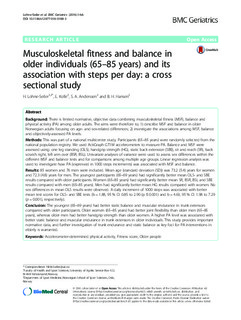| dc.contributor.author | Seiler, Hilde Lohne | |
| dc.contributor.author | Kolle, Elin | |
| dc.contributor.author | Anderssen, Sigmund Alfred | |
| dc.contributor.author | Hansen, Bjørge Herman | |
| dc.date.accessioned | 2016-11-29T13:16:33Z | |
| dc.date.available | 2016-11-29T13:16:33Z | |
| dc.date.issued | 2016-01-12 | |
| dc.identifier.citation | BMC Geriatrics. 2016, 16, 1-11 | nb_NO |
| dc.identifier.uri | http://hdl.handle.net/11250/2423483 | |
| dc.description | © 2016 The Author(s). This is an Open Access article. | nb_NO |
| dc.description.abstract | Background:
There is limited normative, objective data combining musculoskeletal fitness (MSF), balance and physical activity (PA) among older adults. The aims were therefore to; 1) describe MSF and balance in older Norwegian adults focusing on age- and sex-related differences; 2) investigate the associations among MSF, balance and objectively-assessed PA levels.
Methods:
This was part of a national multicenter study. Participants (65–85 years) were randomly selected from the national population registry. We used ActiGraph GT1M accelerometers to measure PA. Balance and MSF were assessed using: one leg standing (OLS), handgrip strength (HG), static back extension (SBE), sit and reach (SR), back scratch right, left arm over (BSR, BSL). Univariate analyses of variance were used to assess sex differences within the different MSF and balance tests and for comparisons among multiple age groups. Linear regression analysis was used to investigate how PA (expressed in 1000 steps increments) was associated with MSF and balance.
Results:
85 women and 76 men were included. Mean age (standard deviation (SD)) was 73.2 (5.4) years for women and 72.3 (4.8) years for men. The youngest participants (65–69 years) had significantly better mean OLS- and SBE results compared with older participants. Women (65–85 years) had significantly better mean SR, BSR, BSL and SBE results compared with men (65–85 years). Men had significantly better mean HG results compared with women. No sex differences in mean OLS results were observed. A daily increment of 1000 steps was associated with better mean test scores for OLS- and SBE tests (b = 1.88, 95 % CI: 0.85 to 2.90 (p ≤ 0.001) and b = 4.63, 95 % CI: 1.98 to 7.29 (p = 0.001), respectively).
Conclusion:
The youngest (65–69 years) had better static balance and muscular endurance in trunk extensors compared with older participants. Older women (65–85 years) had better joint flexibility than older men (65–85 years), whereas older men had better handgrip strength than older women. A higher PA level was associated with better static balance and muscular endurance in trunk extensors in older individuals. This study provides important normative data, and further investigation of trunk endurance and static balance as key foci for PA interventions in elderly is warranted. | nb_NO |
| dc.language.iso | eng | nb_NO |
| dc.publisher | BioMed Central | nb_NO |
| dc.subject | accelerometer-determined physical activity | nb_NO |
| dc.subject | fitness score | nb_NO |
| dc.subject | older people | nb_NO |
| dc.title | Musculoskeletal fitness and balance in older individuals (65–85 years) and its association with steps per day: a cross sectional study | nb_NO |
| dc.type | Journal article | nb_NO |
| dc.type | Peer reviewed | nb_NO |
| dc.subject.nsi | VDP::Medical disciplines: 700::Clinical medical disciplines: 750 | nb_NO |
| dc.source.journal | BMC Geriatrics | nb_NO |
| dc.identifier.doi | 10.1186/s12877-016-0188-3 | |
| dc.description.localcode | Seksjon for idrettsmedisinske fag / Department of Sports Medicine | nb_NO |
